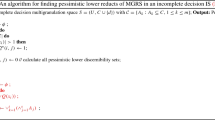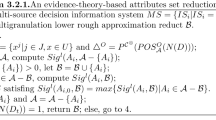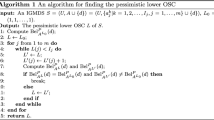Abstract
When multiple granulated knowledge in multigranulation spaces are involved in decision making, protocol principles are adopted to arrive at the final consensus. Multigranulation rough set theory utilizes a voting principle to combine the decision options derived from individual granulated knowledge. Note that those knowledge may provide different degrees of support to the final results, some are key, some are of less importance and some are even of no use. Selecting valuable knowledge and reducing worthless one are thus necessary for data processing, which can alleviate the storage occupancy and facilitate the logical and statistical analysis. However, the basic reduction foundation of multigranulation spaces has been rarely touched by researchers, which brings in many difficulties in algorithmic and real applications. This work aims to disclose the principles of multiple knowledge reduction in multigranulation spaces from the viewpoint of discernibility. First, the notions of knowledge reduction of multigranulation spaces are defined based on multigranulation rough set theory. Second, a decision function mapping each object into the decision options of its neighborhood granule is introduced. Third, several pairs of discernibility matrices and discernibility functions are successively developed using the decision function. We claim that the valuable and worthless knowledge in multigranulation spaces can be explicitly chose and eliminated respectively by using the proposed discernibility matrices and discernibility functions. That is to say, these discernibility tools provide a precise criterion for the knowledge reduction of multigranulation spaces. As a theoretical extension, a multigranulation information entropy is proposed and an approximate algorithm is constructed to compute a suboptimal reduct of a multigranulation space based on this entropy. In the end, numerical experiments are performed on public data sets to verify the effectiveness of the proposed reduction methods. This study can get us a grasp of the foundational principle of knowledge reduction and may bring a new insight for the designation of substantial reduction algorithms of multigranulation knowledge.




Similar content being viewed by others
References
Che XY, Mi JS, Chen DG (2018) Information fusion and numerical characterization of a multi-source information system. Knowl Based Syst 145:121–133
Chen DG, Wang CZ, Hu QH (2007) A new approach to attribute reduction of consistent and inconsistent covering decision systems with covering rough sets. Inf Sci 177:3500–3518
Chen DG, Zhao SY, Zhang L et al (2012) Sample pair selection for attribute reduction with rough set. IEEE Trans Knowl Data Eng 24:2080–2093
Feng T, Mi JS (2016) Variable precision multigranulation decision-theoretic fuzzy rough sets. Knowl Based Syst 91:93–101
Feng QR, Zhou Y (2014) Soft discernibility matrix and its applications in decision making. Appl Soft Comput 24:749–756
Grecoa S, Matarazzoa B, Slowinski R (2001) Rough sets theory for multicriteria decision analysis. Eur J Oper Res 129:1–47
Hu J, Pedrycz W, Wang GY et al (2016) Rough sets in distributed decision information systems. Knowl Based Syst 94:13–22
Jensen R, Shen Q (2004) Semantics-preserving dimensionality reduction: rough and fuzzy-rough-based approaches. IEEE Trans Knowl Data Eng 16:1457–1471
Kaneiwa K (2011) A rough set approach to multiple dataset analysis. Appl Soft Comput 11:2538–2547
Khan M (2016) Formal reasoning in preference-based multiple-source rough set model. Inf Sci 334–335:122–143
Khan M, Banerjee M (2008) Formal reasoning with rough sets in multiple-source approximation systems. Int J Approx Reason 49:466–477
Kong QZ, Zhang XW, Xu WH (2019) Attribute reducts of multi-granulation information system. Artif Intell Rev. https://doi.org/10.1007/s10462-019-09699-3
Kumar S, Inbarani H (2015) Optimistic multi-granulation rough set based classification for medical diagnosis. Proc Comput Sci 47:374–382
Li JH, Ren Y, Mei CL et al (2016) A comparative study of multigranulation rough sets and concept lattices via rule acquisition. Knowl Based Syst 91:152–164
Liang JY, Wang F, Dang CY et al (2012) An efficient rough feature selsction algorithm with a multi-granulation view. Int J Approx Reason 53:1080–1093
Liang JY, Wang F, Dang CY et al (2014) A group incremental approach to feature selection applying rough set technique. IEEE Trans Knowl Data Eng 26:294–308
Lin TY (1997) From rough sets and neighborhood systems to information granulation and computing in words. In: Proceeding Europe congress intelligent techniques and soft computing, 8–12 Sept 1997, pp 1602–1606
Lin GP, Liang JY, Qian YH (2015) An information fusion approach by combining multigranulation rough sets and evidence theory. Inf Sci 314:184–199
Liu CH, Miao DQ, Qian J (2014) On multi-granulation covering rough sets. Int J Approx Reason 55:1404–1418
Mi JS, Leung Y, Wu WZ (2011) Dependence-space-based attribute reduction in consistent decision tables. Soft Comput 15:261–268
Pawlak Z (1991) Rough sets: theoretical aspects of reasoning about data. Kluwer Academic Publishers, Dordrecht
Pedrycz W (2002) Relational and directional aspects in the construction of information granules. IEEE Trans Syst Man Cybern Part A 32:605–614
Qian YH, Liang JY, Yao YY et al (2010a) MGRS: a multi-granulation rough set. Inf Sci 180:949–970
Qian YH, Liang JY, Yao YY et al (2010b) Incomplete mutigranulation rough set. IEEE Trans Syst Man Cybern A Syst Hum 20:420–430
Qian YH, Li SY, Liang JY et al (2014a) Pessimistic rough set based decisions: a multigranulation fusion strategy. Inf Sci 264:196–210
Qian YH, Zhang H, Sang YL et al (2014b) Multigranulation decision-theoretic rough sets. Int J Approx Reason 55:225–237
Qian YH, Liang JY, Lin GP et al (2015) Fuzzy granular structure distance. IEEE Trans Fuzzy Syst 23:2245–2259
Rauszer CM (1992) Rough logic for multi-agent systems. In: International conference on logic at work. Springer, Berlin, pp 161–181
She YH, He XL (2012) On the structure of the multigranulation rough set model. Knowl Based Syst 36:81–92
Skowron A (1993) Boolean reasoning for decision rules generation. In: Proceedings of the international symposium on methodologies for intelligent systems, pp 295–305
Skowron A, Rauszer C (1992) The discernibility matrices and functions in information systems. In: Slowiński R (ed) Intelligent decision support. Handbook of applications and advances of the rough sets theory. Kluwer, Dordrecht
Słezak D (2002) Approximate entropy reducts. Fund Inform 53:365–390
Slowinski R, Vanderpooten D (2000) A generalized definition of rough approximations based on similarity. IEEE Trans Knowl Data Eng 12:331–336
Sun BZ, Ma WM (2014) Soft fuzzy rough sets and its application in decision-making. Artif Intell Rev 41:67–80
Sun BZ, Ma WM (2015) An approach to consensus measurement of linguistic preference relations in multi-attribute group decision making and application. Omega 51:83–92
Sun BZ, Ma WM (2016) An approach to evaluation of emergency plans for unconventional emergency events based on soft fuzzy rough set. Kybernetes 45:1–26
Tan AH, Wu WZ, Li JJ et al (2016) Evidence-theory-based numerical characterization of multigranulation rough sets in incomplete information systems. Fuzzy Sets Syst 294:18–35
Tan AH, Wu WZ, Tao YZ (2017) On the belief structures and reductions of multigranulation spaces with decisions. Int J Approx Reason 88:39–52
Tan AH, Wu WZ, Qian YH et al (2019) Intuitionistic fuzzy rough set-based granular structures and attribute subset selection. IEEE Trans Fuzzy Syst 27:527–539
Teng SH, Lu M, Yang AF et al (2016) Efficient attribute reduction from the viewpoint of discernibility. Inf Sci 326:297–314
Tsang ECC, Chen DG, Yeung DS et al (2008) Attributes reduction using fuzzy rough sets. IEEE Trans Fuzzy Syst 16:1130–1141
Wei W, Liang JY (2019) Information fusion in rough set theory: an overview. Inform Fusion 48:107–118
Wu WZ, Leung Y (2013) Optimal scale selection for multi-scale decision tables. Int J Approx Reason 54:1107–1129
Xu WH, Yang JH (2017) A novel approach to information fusion in multi-source datasets: a granular computing viewpoint. Inf Sci 378:410–423
Xu WH, Li WT, Zhang XT (2017) Generalized multigranulation rough sets and optimal granularity selection. Granul Comput 2:271–288
Yang XB, Xu SP, Dou HL et al (2017) Multigranulation rough set: a multiset based strategy. Int J Comput Int Syst 10:277–292
Yao YY (1999) Granular computing: basis issues and possible solutions. In: Proceedings of the 5th joint conference on information science 1999, pp 186–189
Yao YY (2005) Perspectives of granular computing. In: IEEE international conference on granular computing, vol 1, pp 85–90
Yao YY, She YH (2016) Rough set models in multigranulation spaces. Inf Sci 327:40–56
Yao YY, Zhao Y (2009) Discernibility matrix simplification for constructing attribute reducts. Inf Sci 179:867–882
Young T (2000) Data mining and machine oriented modeling: a granular computing approach. Appl Intell 13:113–124
Zadeh LA (1997) Toward a theory of fuzzy information granulation and its centrality in human reasoning and fuzzy logic. Fuzzy Sets Syst 90:111–127
Zadeh LA (1998) Some reflections on soft computing, granular and their roles in the conception, design and utilization of information/intelligent systems. Soft Comput 2:23–25
Zhan JM, Alcantud JCR (2019) A novel type of soft rough covering and its application to multicriteria group decision making. Artif Intell Rev. https://doi.org/10.1007/s10462-018-9617-3
Zhan JM, Sun BZ (2019) Covering-based intuitionistic fuzzy rough sets and applications in multi-attribute decision-making. Artif Intell Rev. https://doi.org/10.1007/s10462-018-9674-7
Zhang QH, Zhang T (2016) Binary classification of multigranulation searching algorithm based on probabilistic decision. Math Probl Eng 2:1–14
Zhang QH, Zhang Q, Wang GY (2016) The uncertainty of probabilistic rough sets in multi-granulation spaces. Int J Approx Reason 77:38–54
Zhao Y, Yao YY (2007) Data analysis based on discernibility and indiscernibility. Inf Sci 177:4959–4976
Acknowledgements
This work is supported by the grants from National Natural Science Foundation of China (61602415, 61573321, 41631179, 11871259, 61773349, and 41701447), the Natural Science Foundation of Zhejiang Province (LY18F030017) and the Natural Science Foundation of Fujian Province (2019J01748).
Author information
Authors and Affiliations
Corresponding author
Additional information
Publisher's Note
Springer Nature remains neutral with regard to jurisdictional claims in published maps and institutional affiliations.
Rights and permissions
About this article
Cite this article
Tan, A., Wu, WZ., Li, J. et al. Reduction foundation with multigranulation rough sets using discernibility. Artif Intell Rev 53, 2425–2452 (2020). https://doi.org/10.1007/s10462-019-09737-0
Published:
Issue Date:
DOI: https://doi.org/10.1007/s10462-019-09737-0




